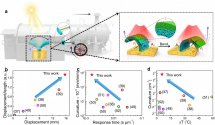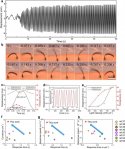You are using an out of date browser. It may not display this or other websites correctly.
You should upgrade or use an alternative browser.
You should upgrade or use an alternative browser.
News on China's scientific and technological development.
- Thread starter Quickie
- Start date
This one is very old something like 4 to 5 years.Challenges and strategies in high-accuracy manufacturing of the world’s largest SiC aspheric mirror
Abstract
In the process of manufacturing the world’s largest silicon carbide (SiC) aspheric mirror, the primary difficulties are mirror blank preparation, asphere fabrication, and testing, as well as cladding and coating. Specifically, the challenges include the homogeneity of the complicated structure casting, accuracy and efficiency of the fabrication process, print-through effect, fidelity and precision of test procedure, stress and denseness of cladding process, the dynamic range of interferometric measurement, and air turbulence error due to the long optical path. To break through such a barrier of difficulties, we proposed the water-soluble room temperature vanishing mold and gel casting technology, homogeneous microstructure reaction-formed joint technology, nano-accuracy efficient compound fabrication, gravity unloading technology, high-denseness low-defect physical vapor deposition (PVD) Si-cladding technology, test data fusion method, and time-domain averaging method, etc. Based on the proposed technologies and methods, we have accomplished the world’s largest SiC aspheric mirror with a size of ⌀4.03 m. The impressive performance of the SiC aspheric mirror is validated by the characteristics of the fabricated SiC aspheric mirror. The aerial density of the SiC blank is less than 120 kg/m2, surface shape test accuracy is better than 6 nm RMS, thickness inhomogeneity of the cladding layer is less than 5%, and the final surface figure error and roughness are 15.2 nm RMS and 0.8 nm RMS, respectively.
View attachment 100225
This could be used to develop big EUV mirrors.
We just saw Beihang University setting world record for flight duration of their ornithopter a few days ago. Now we have this report on the ornithopters from Northwestern Polytechnical University:
Check out the embedded video clip for the different ornithopters they have made. One of their ornithopters recently completed a flight of 123 minutes.
This team from NPU has been working on ornithopters since 2001. They have built up a porfolio of more than 100 patents and completed more than 3000 thousand flight tests in more than 20 different locations in China, including places 4300 meters above the sea level in Tibet.
Check out the embedded video clip for the different ornithopters they have made. One of their ornithopters recently completed a flight of 123 minutes.
This team from NPU has been working on ornithopters since 2001. They have built up a porfolio of more than 100 patents and completed more than 3000 thousand flight tests in more than 20 different locations in China, including places 4300 meters above the sea level in Tibet.
西部网讯(记者 李卓然)123分钟,这是由西北工业大学航空学院教授宋笔锋团队自主研制的“云鸮”仿生扑翼飞行器的单次连续飞行时间。10月26日,记者从西北工业大学了解到,这一时间已通过国家专业认证机构的现场检测。
梭形身躯,在飞行中,一对翅膀像鸟一样展开并扇动飞翔,这是此次研发的“云鸮”仿生扑翼飞行器在空中飞行的样子。据了解,“云鸮”仿生扑翼飞行器,是宋笔锋教授团队20多年深耕鸟类飞行机理探索和应用研究的最新成果。
什么是鸟类飞行机理研究?宋笔锋教授告诉记者,在扑动翼设计方面,团队基于对鸟类翅膀高升力、大推力和低阻力气动机理的研究,提出了高效仿生翼气动外形和结构设计方法,从而使得扑动翼在飞行过程中具有最佳的升阻气动特性和推进效果,提高了飞行器的飞行效率和续航性能。
宋笔锋说,仿生扑翼飞行器是模仿鸟类等生物扑动翅膀的飞行方式,这样的飞行方式在微小型飞行器尺度,具有实现长距离飞行的潜力,同时由于扑动翼具有较多的运动自由度,具有较强的机动性。“不仅如此,仿生扑翼飞行器具有仿生性、隐蔽性和便携性,一般为手抛起飞、滑翔降落,起降不受场地限制,还可以像微小型固定翼飞行器那样实现快速高飞、长距离巡航等。”
据悉,西北工业大学仿生飞行器研究团队由宋笔锋教授领衔,从2001年开始,已在仿生飞行技术领域深耕20多年,突破了低雷诺数/非定常空气动力学计算与试验、高性能仿生扑动翼设计、高效扑动机构设计和适合扑翼飞行器的微型飞控系统研制等难题,先后研制了“信鸽”“小隼”“金雀”“蜂鸟”“云鸮”“信天翁”等不同特点的仿生飞行器,得到了陈一坚、唐长红、杨伟等多位航空领域院士的肯定,已获授权发明专利100余项,先后获得陕西省科学技术奖一等奖、首届中航工业杯-国际无人飞行器创新大奖赛优秀创意一等奖等。
截至目前,团队研制的仿生扑翼飞行器已在北京、沈阳、深圳、北川、羊八井(海拔4300m)、稻城(海拔4100m)等全国20余个地区完成了3000余架次任务飞行,能在-10~40℃、4级风及小雨雪环境下使用。已在陕西省地质局、青海湖风景区等多个单位进行了试点应用。
未来,西北工业大学仿生飞行器研究团队将继续秉承西工大“三实一新”的校风,坚守航空报国的使命担当,砥砺前行,为航空强国建设贡献力量。
Chinese scientists developed "artificial muscle" to convert solar energy directly to continuous mechanical work.
Oscillating light engine realized by photothermal solvent evaporation
Abstract
Continuous mechanical work output can be generated by using combustion engines and electric motors, as well as actuators, through on/off control via external stimuli. Solar energy has been used to generate electricity and heat in human daily life; however, the direct conversion of solar energy to continuous mechanical work has not been realized. In this work, a solar engine is developed using an oscillating actuator, which is realized through an alternating volume decrease of each side of a polypropylene/carbon black polymer film induced by photothermal-derived solvent evaporation. The anisotropic solvent evaporation and fast gradient diffusion in the polymer film sustains oscillating bending actuation under the illumination of divergent light. This light-driven oscillator shows excellent oscillation performance, excellent loading capability, and high energy conversion efficiency, and it can never stop with solvent supply. The oscillator can cyclically lift up a load and output work, exhibiting a maximum specific work of 30.9 × 10−5 J g−1 and a maximum specific power of 15.4 × 10−5 W g−1 under infrared light. This work can inspire the development of autonomous devices and provide a design strategy for solar engines.
In summary, self-oscillating actuators were achieved under divergent light, including sunlight, simulated sunlight, and infrared light, by using photothermal- induced alternating solvent evaporation from a porous PP/CB film. The actuator showed the largest oscillation displacement (15.7 mm) and amplitude (7.3 cm−1 or 224°) at a smaller temperature change (5.8 °C) compared to the oscillating actuators driven by light reported thus far. The excellent self-oscillation performance originated from the indispensable combination of the fast volume shrinkage and recovery due to the fast solvent evaporation and supply, appropriate modulus, and high flexibility of the PP/CB film, and the oscillation can never stop under continuous solvent supply. In addition, oscillating actuation can occur for the PP/CB film at different tilt angles under divergent light with different incident angles, and is applicable to a variety of volatile polar solvents, which can be used for leakage monitoring of volatile organic vapor. Moreover, oscillating actuation can still occur when carrying a load and can be used in different scenarios such as signal transmission, sensors, and controllers by replacing the loads with different functional components. The oscillating actuation can open or close a valve under light irradiation, and therefore serves as a controller to control the transmission of liquid, gas, or even light. Because the oscillating amplitude and frequency is sensitive to the light source and different types of organic solvents, it can serve as a sensor to the light intensity and wavelength by employing different types of pigments. The oscillating actuation during light transmission can be used to modulate the light signal during signal transmission.
我国学者研获自振荡“太阳能人工肌肉发动机”
晒晒太阳就能振动,光照不停、振动不止。作为重要的绿色能源,太阳能一直被人类寄予厚望。然而,能否省去光电转化环节,直接将太阳能转化为稳定、持续的机械能?
日前,我国科学家研获一种基于多孔薄膜的自振荡“太阳能人工肌肉驱动器”,并探索了作为发动机的应用,将这一大胆想象变为现实,为人类高效利用太阳能开辟了一条新路径。介绍该研究工作的论文发表于国际知名学术期刊《自然—通讯》上。
这种基于多孔柔性聚丙烯/炭黑薄膜的自振荡人工肌肉驱动器由南开大学教授刘遵峰、陈永胜,中国药科大学副教授周湘合作团队共同设计。他们在这一原理突破的基础上,开发出“太阳能人工肌肉发动机”。
驱动器是一种在外界环境刺激下产生机械变形,并将光能、热能、化学能等各种环境能量转换为机械能,从而产生驱动力的硬件,也是微机电系统、光发动机等应用场景中不可或缺的核心部件。研发一种自发且持续实现能量转化的软体驱动器是该领域的关键难点之一。
“自振荡是生物有机体的一个重要特性,比如心脏跳动、细胞循环等,为设计连续运动的软体机器人及自主智能装置提供了方向。”刘遵峰介绍,目前已有科研团队成功构建了光响应自振荡驱动器,然而,在太阳光等散射光刺激下发生自振荡运动并用于机械做功始终没能实现。
研究人员发现,聚合物薄膜中的溶剂蒸发会导致体积收缩且光照射薄膜一侧会加速薄膜内部溶剂蒸发,导致各向异性体积收缩,从而产生向光弯曲。“实验证明,在薄膜中引入多孔结构可以有效促进溶剂分子的质量传递,从而导致薄膜材料发生更快的弯曲速度和更大的弯曲幅度。因此,我们认为,基于多孔薄膜的光诱导溶剂蒸发可能是实现自振荡驱动的良好候选者。”刘遵峰说。
在上述研究的基础上,这支联合研究团队研最终设计研发出这种基于太阳光的自振荡驱动薄膜。它主要通过光热衍生的溶剂蒸发引起的聚丙烯/炭黑聚合物薄膜两侧的交替体积减小实现振动。聚合物薄膜中的各向异性溶剂蒸发和快速梯度扩散在发散光的照射下维持振荡弯曲驱动。
据介绍,该工作首次实现了在包括太阳光、红外光和模拟太阳光等发散光下的自振荡驱动,也实现了在不同发散光照射角度下的自振荡运动。这种光响应自振荡驱动器具有优异的振荡做功性能、出色的负载能力和较高的能量转换效率(0.9%),并在溶剂不断供应的情况下保持持续振荡运动,不会停止。
“这项工作为‘太阳能发动机’提供了一种全新的设计策略,有助于自驱动设备的研发,并将促进其他领域跨学科交叉,助力智能材料、柔性器件等智能设备领域的快速发展。”陈永胜说。
Attachments
As Kunlun chip got integrated with Baidu Paddle Paddle AI platform with the completion of level 3 compatibility testing (the first to achieve this level all year), they had a presentation for people on how you can use Kunlun with Paddle Paddle platform.
As Nvidia chips are getting banned, Paddle Paddle is integrating as many domestic AI chips as possible. In this case, it talks about the steps that need to be taken. They need to be mass produced and have a software ecosystem. They need to also commercialize it and lower the cost of the platform. They talked about the path since 2020 until now when Kunlun has become a major partner on Paddle Paddle and the software/hardware integration. The Kunlun SDK sits on top of the chip itself in terms of integration. Paddle Paddle is integrated with Kunlun SDK, so you can write logic on Paddle Paddle that makes calls to Kunlun SDK. And then you have different applications that can utilize the Paddle Paddle language. I'm not sure I understand enough about AI and Machine learning to talk more about this.
As Nvidia chips are getting banned, Paddle Paddle is integrating as many domestic AI chips as possible. In this case, it talks about the steps that need to be taken. They need to be mass produced and have a software ecosystem. They need to also commercialize it and lower the cost of the platform. They talked about the path since 2020 until now when Kunlun has become a major partner on Paddle Paddle and the software/hardware integration. The Kunlun SDK sits on top of the chip itself in terms of integration. Paddle Paddle is integrated with Kunlun SDK, so you can write logic on Paddle Paddle that makes calls to Kunlun SDK. And then you have different applications that can utilize the Paddle Paddle language. I'm not sure I understand enough about AI and Machine learning to talk more about this.
As a carry over from semiconductor thread on data center building. It looks like a new high tech export item or infrastructure item that China is embarking.
I see here that China is building a new data center in Johor (which is right across the border from Singapore)
Looking at their website, they have also built data centers in
Mumbai, Bangkok, Kuala Lumpur (actually 3 in KL)
Aside from this, we also know that China is building data centers in Saudi Arabia with Alibaba and Huawei
and I think UAE for sure.
And we know that Huawei and other companies have already been building a lot of data centers in Africa.
I see here that China is building a new data center in Johor (which is right across the border from Singapore)
Looking at their website, they have also built data centers in
Mumbai, Bangkok, Kuala Lumpur (actually 3 in KL)
Aside from this, we also know that China is building data centers in Saudi Arabia with Alibaba and Huawei
and I think UAE for sure.
And we know that Huawei and other companies have already been building a lot of data centers in Africa.



